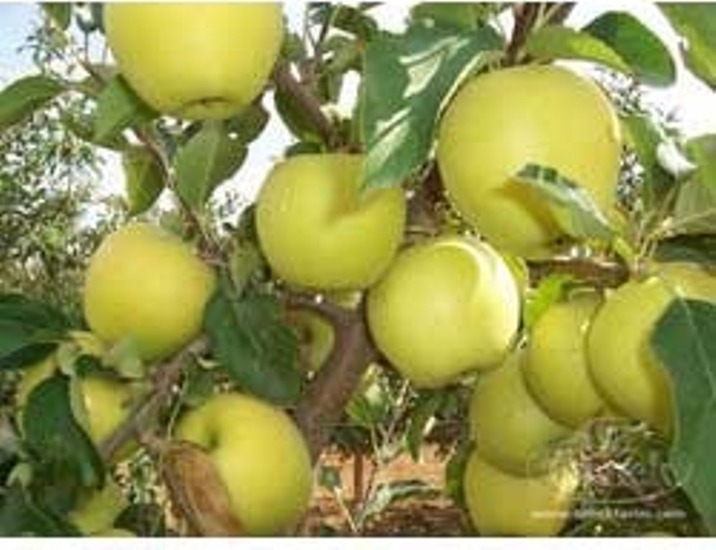How would you like a sweet, aromatic apple with long shelf-life. Kashmir had it but lost it because of lack of access to Middle East market where it was in huge demand. Syed Asma reports.

A red coloured, yellow striped, medium-sized apple known for its sweet taste and aroma is not found in the local market anymore, though it was the apple of choice for many decades in Kashmir.
Ambre was a brand name; “an ideal fruit” in Kashmir, says octogenarian Abdul Rahim of Shopian. “It dominated the taste of Kashmiris for long. You have not tasted it otherwise you would long for it like I do,” he adds.
Some researchers and scientists believe that the species trace its origin from Central Asia. The varieties of Ambre that were cultivated in Kashmir were Dodhi Ambre, Chari Ambre, Walayati Ambre and Mah Ambre. The areas famous for these varieties or Ambre as a whole were Sopore, Islamabad, Shopian and few belts of Pulwama.
Ambre over the decades had secured a safe place in the Valley as it adapted well to the harsh winters here, where mercury would dip much below zero.
People used to store it for months together. “Ambre had a long shelf life. It would remain fresh for months even if not stored properly,” says Irfan Bisati, Assistant Professor, Directorate of Extension in Sher-e-Kashmir University of Agricultural Science and Technology, Kashmir (SKUAST-K). “The fruit growers used to store it under soil to increase its shelf life and to have it available in the market during winters”.
Besides remaining in high demand in the valley, Ambre apple also added good amount to Valley’s economy. Ambre was one of the important products in Valley’s agro-industry.
“It was supplied to most of the Gulf countries via Karachi and was in a lot of demand in those places. As access to these places was snapped after 1947, the Ambre appel could not reach the markets outside Kashmir where it was in demand,” says Prof. K D Farooqui, an Emeritus Scientist at SKUAST (K).
According to Irfan Bisati, “The major setback in the production of Ambre was its less demand in Indian market which was the only left market for the fruit”.
Demand for other varieties increased which overshadowed “once the King of all fruits in Kashmir”. Other factors which made things worse were the diseases that hit the Ambre tree and the long time taken to bear fruit, he added.
An Ambre tree takes 10 to 12 years to bear fruit. So when the demand in the market decreased, people stopped cultivating Ambre apple trees.
The then existing Ambre trees did not produce good quantity of fruit every year as the production decreases in every alternate year, says Irfan.
“Simple techniques like pruning or artificial thinning of flowers could have easily helped to reduce the problem but lack of knowledge among the Ambre growers proved to be disastrous for the plant species,” he adds.
In pruning and artificial thinning, number of flowers is reduced either by cutting few branches or by cutting few flowers which helps in even distribution of fruits hence does not over burden the tree which causes alternate bearing.
Another problem that proved detrimental for the Ambre trees was the appearance of fungal disease, apple scab, in Kashmir, which affected entire crops. The diseased fruit develop olive or brownish spots which disfigures the fruit.
To save the fruit, expensive fungicide sprays were required, pushing up the production costs and putting pressure on profits of growers already battered by a lowering demand of the fruit.
The then state government subsidized the requisite fungicides but that too could not save the Ambre fruit.
Prof K D Farooqui, has been working on Ambre apple since 1980’s.
“Farmers made effort to save the species but by the corruption prevalent in the market and adulterated fungicides made available to the farmers worsened the condition of the Ambre industry,” says Prof. Farooqui.
Agriculture scientists have been making efforts to produce scab-resistant species of Ambre plants. Their thrust was genetic control. Prof. Farooqui claims to have succeeded in producing a couple of scab-resistant varieties of Ambre apple. Few of the varieties that he produced are Lal Ambre (a cross of Red Delicious and Ambre), Firdous (a cross of Ambre and Prima) and Sunhari (a cross of Golden Delicious and Ambre).
Agriculture scientists say that it can be revived, but we don’t find any Ambre trees in the orchards.
Other fruit species which got extinct In Cherries, Glasse: White heart. In Pear, Tae`ng: Nakh Satrivati, Nakh Gulabi, Gosh Bug, harnakh, Walwatlano, Kotarnal, Sikritae`ng, Mamitae`ng and Jagir Tae`ng.















